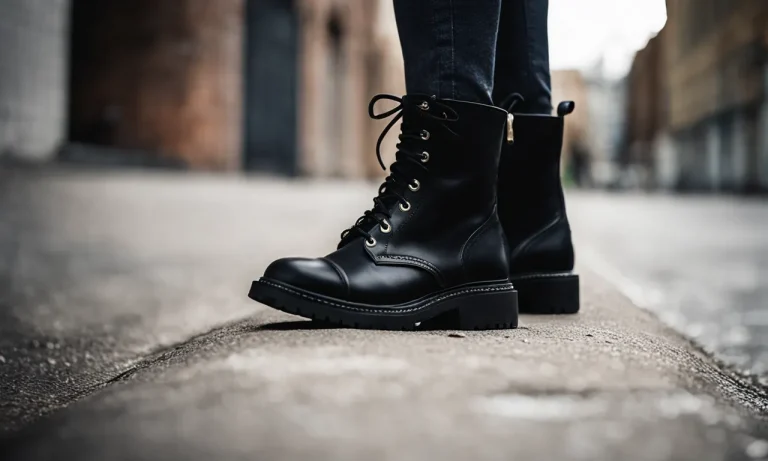Having a pair of broken shoes can be frustrating. Whether it’s a loose sole, torn upper, or worn heel, shoe damage can happen when you least expect it. Luckily, many common shoe problems can be fixed at home with a few simple tools and techniques.
Read on to learn the best DIY methods for repairing all types of shoe damage.
If you need a quick answer: Use shoe glue or rubber cement to reattach loose soles. Patch holes and tears with a shoe repair patch kit. Replace heel tips with heel savers. Condition the upper with leather or vinyl conditioner to restore flexibility.
Assessing the Damage
Before diving into the process of fixing your shoe, it’s important to carefully assess the damage. By taking the time to examine the various parts of your shoe, you can determine the extent of the problem and the appropriate steps for repair. Here are some key areas to focus on:
Look at the sole
The sole of the shoe is the part that comes into direct contact with the ground, so it’s prone to wear and tear. Inspect the sole for any signs of damage such as cracks, holes, or excessive wear. If the sole is severely damaged, it may need to be replaced entirely.
However, if the damage is minor, you can consider using adhesive or shoe repair glue to fix it.
Inspect the upper
The upper part of the shoe refers to the material that covers the foot. Check for any tears, loose threads, or discoloration. If the damage is limited to a small area, you can mend it using a needle and thread.
However, if the upper is extensively damaged, it may require professional repair or replacement.
Check the heel and heel counter
The heel and heel counter provide support and stability to the shoe. Examine these areas for any cracks, loose parts, or uneven wear. If the damage is minor, you can try using shoe glue to repair it. However, if the damage is significant or affects the shoe’s structure, it’s recommended to seek professional help.
Remember, assessing the damage is crucial to determine the best course of action for fixing your shoe. If you’re unsure or the damage seems severe, it’s always wise to consult a professional shoemaker or cobbler who can provide expert advice and assistance.
Repairing the Sole
When it comes to fixing a shoe, one of the most common issues is a loose sole. Fortunately, reattaching a loose sole is a relatively simple process that can be done at home. Here’s a step-by-step guide to help you get started:
Reattaching loose soles
1. Clean the sole: Use a cloth or brush to remove any dirt or debris from the sole of the shoe. This will ensure that the adhesive sticks properly.
2. Apply adhesive: Choose a strong adhesive that is suitable for shoe repair. Apply a thin, even layer of adhesive to both the sole and the shoe. Make sure to cover the entire area that needs to be reattached.
3. Press the sole: Press the sole firmly against the shoe, making sure that it is aligned correctly. Apply pressure for a few minutes to allow the adhesive to bond properly.
4. Let it dry: Allow the shoe to dry for the recommended time specified on the adhesive packaging. This will ensure that the bond is strong and durable.
5. Test the bond: Once the adhesive has dried, gently tug on the sole to ensure that it is securely attached. If it feels loose, repeat the process with additional adhesive.
Filling worn treads
Over time, the treads on the sole of a shoe can wear down, making it slippery and unsafe to walk in. To fix this issue, you can fill in the worn treads using a few simple steps:
1. Clean the treads: Remove any dirt or debris from the worn treads using a cloth or brush.
2. Choose a filler material: There are various options for filling worn treads, such as shoe repair putty or adhesive with rubber particles. Choose a filler material that is suitable for the type of shoe you are repairing.
3. Apply the filler: Fill the worn treads with the chosen filler material, making sure to cover the entire area. Use a spatula or your fingers to press the filler into the treads firmly.
4. Smooth and level: Once the treads are filled, use a spatula or your fingers to smooth and level the filler. This will ensure that the sole is even and comfortable to walk on.
5. Let it dry: Allow the filler to dry for the recommended time specified on the product packaging. This will ensure that it sets properly and provides a durable repair.
Remember, if you’re unsure about any step or if the damage to your shoe is extensive, it’s always best to consult a professional shoe repair service. They have the expertise and tools to handle more complex repairs and ensure that your shoes are restored to their former glory.
Fixing the Upper
When it comes to fixing a shoe, one of the first steps is to address any issues with the upper. The upper refers to the part of the shoe that covers the foot. It is important to fix any holes or tears in the upper to prevent further damage and ensure the shoe’s longevity.
Patching holes and tears
If your shoe has a hole or tear in the upper, there are a few steps you can take to patch it up. First, clean the area around the hole or tear with a damp cloth to remove any dirt or debris. Then, apply a small amount of shoe glue or adhesive to the damaged area and press it together firmly.
Allow the glue to dry completely before wearing the shoe again. If the hole or tear is larger, you may need to use a patch or fabric that matches the color and material of the shoe. Cut the patch to fit the damaged area and secure it with shoe glue or adhesive.
It’s important to ensure that the patch is securely attached to prevent it from coming loose during use.
Sealing the seams
In addition to patching holes and tears, it’s also important to seal the seams of the shoe’s upper. Sealing the seams helps to prevent water and dirt from entering the shoe, which can lead to further damage. To seal the seams, you can use a specialized seam sealer or a waterproofing spray.
Apply the sealer or spray to the seams of the shoe, making sure to cover all areas thoroughly. Allow the sealer or spray to dry completely before wearing the shoe. This simple step can greatly extend the lifespan of your shoes and keep them looking great for longer.
Remember, when fixing the upper of a shoe, it’s important to use the right materials and techniques to ensure a long-lasting repair. If you’re unsure about how to fix a specific issue with your shoe, it’s always a good idea to consult a professional or refer to reputable sources such as www.shoerepair.org.
They can provide guidance and advice on the best approach to fix your shoe and ensure it’s good as new.
Replacing Heel Tips
Heel tips are an important component of any shoe, as they provide traction and support while walking. Over time, these heel tips can wear down and become damaged, making it necessary to replace them. Fortunately, replacing heel tips is a relatively simple process that can be done at home with a few basic tools.
Step 1: Gather the necessary tools
Before you begin, make sure you have the following tools on hand:
- A pair of pliers
- A small screwdriver
- New heel tips
- A hammer
Having these tools readily available will ensure a smooth and efficient replacement process.
Step 2: Remove the old heel tips
Using the pliers, grip the old heel tip firmly and twist it counterclockwise to loosen it. Once it’s loose, you can easily pull it off with your fingers. If the heel tip is stubborn and doesn’t come off easily, you can use the small screwdriver to pry it off gently.
Step 3: Clean the heel base
After removing the old heel tip, take a moment to clean the heel base. Use a damp cloth or a cotton swab to remove any dirt or debris that may have accumulated. This will ensure a proper fit for the new heel tip.
Step 4: Attach the new heel tip
Take the new heel tip and align it with the heel base. Place it on top and gently tap it into place using the hammer. Make sure it is securely attached and sits flush with the shoe. If needed, you can use the pliers to twist it clockwise to tighten it further.
Step 5: Test and adjust
Once the new heel tip is in place, give it a few gentle taps to ensure it is securely attached. Walk around on a flat surface to test its stability and comfort. If necessary, make any adjustments by tightening or loosening the heel tip with the pliers.
Replacing heel tips is a simple and cost-effective way to extend the life of your shoes. By following these step-by-step instructions, you can easily replace the heel tips and continue enjoying your favorite pair of shoes for a long time.
Conditioning and Protection
When it comes to fixing a shoe, it’s not just about repairing visible damage. It’s also important to take steps to condition and protect your shoes to ensure their longevity. This section will cover three key aspects of conditioning and protection: cleaning, leather conditioner, and protective sprays.
Cleaning
Before applying any conditioning or protective products, it’s crucial to clean your shoes properly. Start by removing any loose dirt or debris with a soft brush or cloth. For more stubborn stains, use a mild soap or specialized shoe cleaner.
Gently scrub the affected area with a soft brush or sponge, then wipe it clean with a damp cloth. Allow your shoes to air dry completely before moving on to the next step.
Leather conditioner
Leather shoes require regular conditioning to keep them soft, supple, and resistant to cracking. Leather conditioner helps to restore moisture and replenish natural oils that may have been lost over time.
Apply a small amount of conditioner to a clean cloth and rub it into the leather in circular motions. Pay extra attention to areas that tend to dry out, such as the toe cap or heel. Let the conditioner soak in for a few minutes, then wipe off any excess with a clean cloth.
Repeat this process every few months or as needed to keep your leather shoes in top condition.
Protective sprays
To protect your shoes from water damage and stains, consider using a protective spray. These sprays create a protective barrier that repels liquids and prevents them from seeping into the material. Before applying the spray, ensure that your shoes are clean and dry.
Hold the can approximately 6 inches away from the shoes and spray evenly, covering the entire surface. Allow the spray to dry completely before wearing your shoes. Reapply the protective spray every few months or after exposure to heavy rain or spills to maintain the protective barrier.
Remember, proper conditioning and protection can significantly extend the lifespan of your shoes and keep them looking great for years to come. By following these steps and incorporating them into your shoe care routine, you’ll be able to fix and maintain your shoes with ease!
Conclusion
With the right materials and techniques, you can give your damaged shoes new life. Simple fixes like gluing loose soles or patching holes are easy DIY solutions. For more complex issues, don’t hesitate to seek help from a professional cobbler.
With a bit of care and elbow grease, you can keep your favorite shoes in service for years to come.






